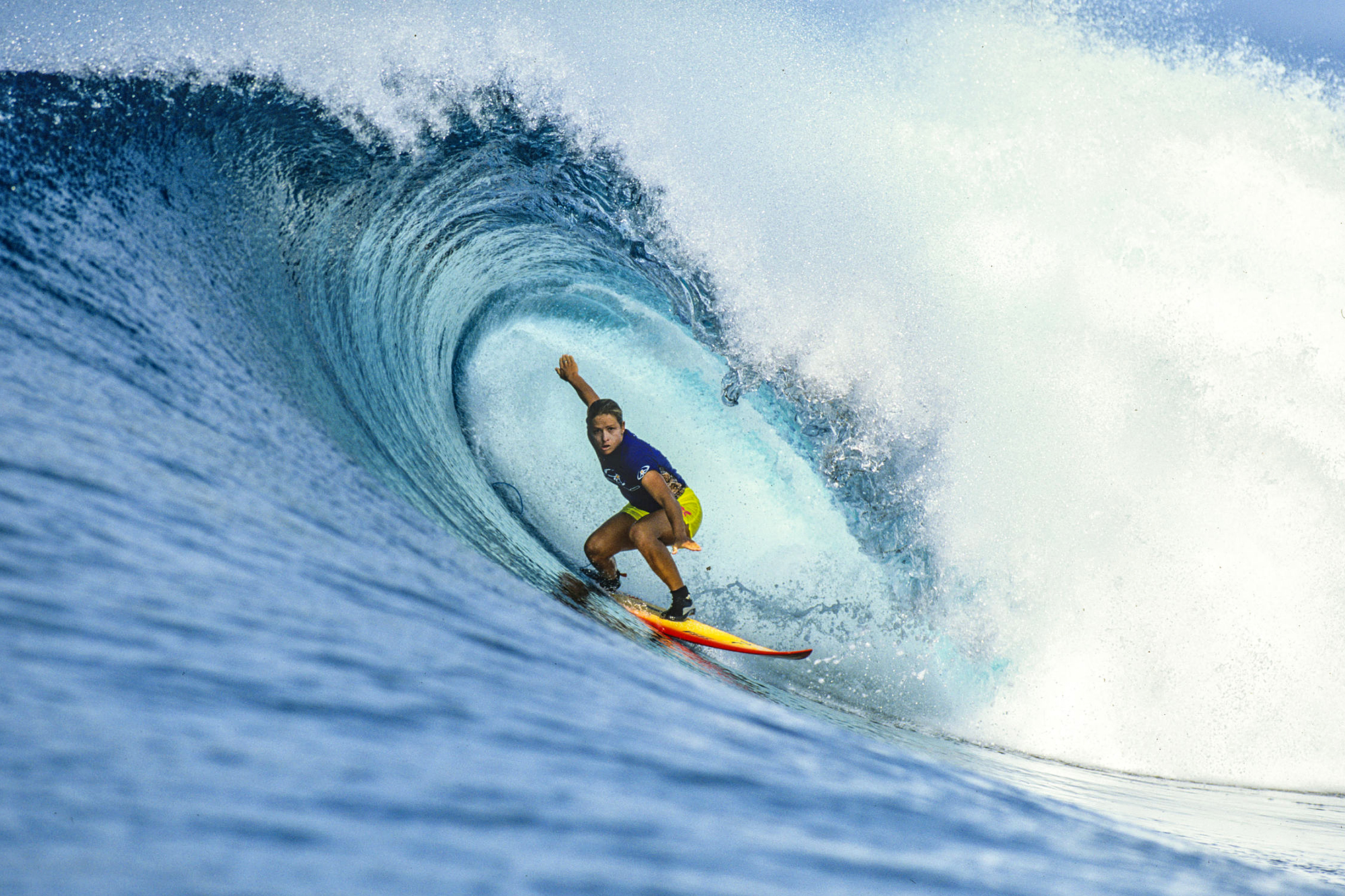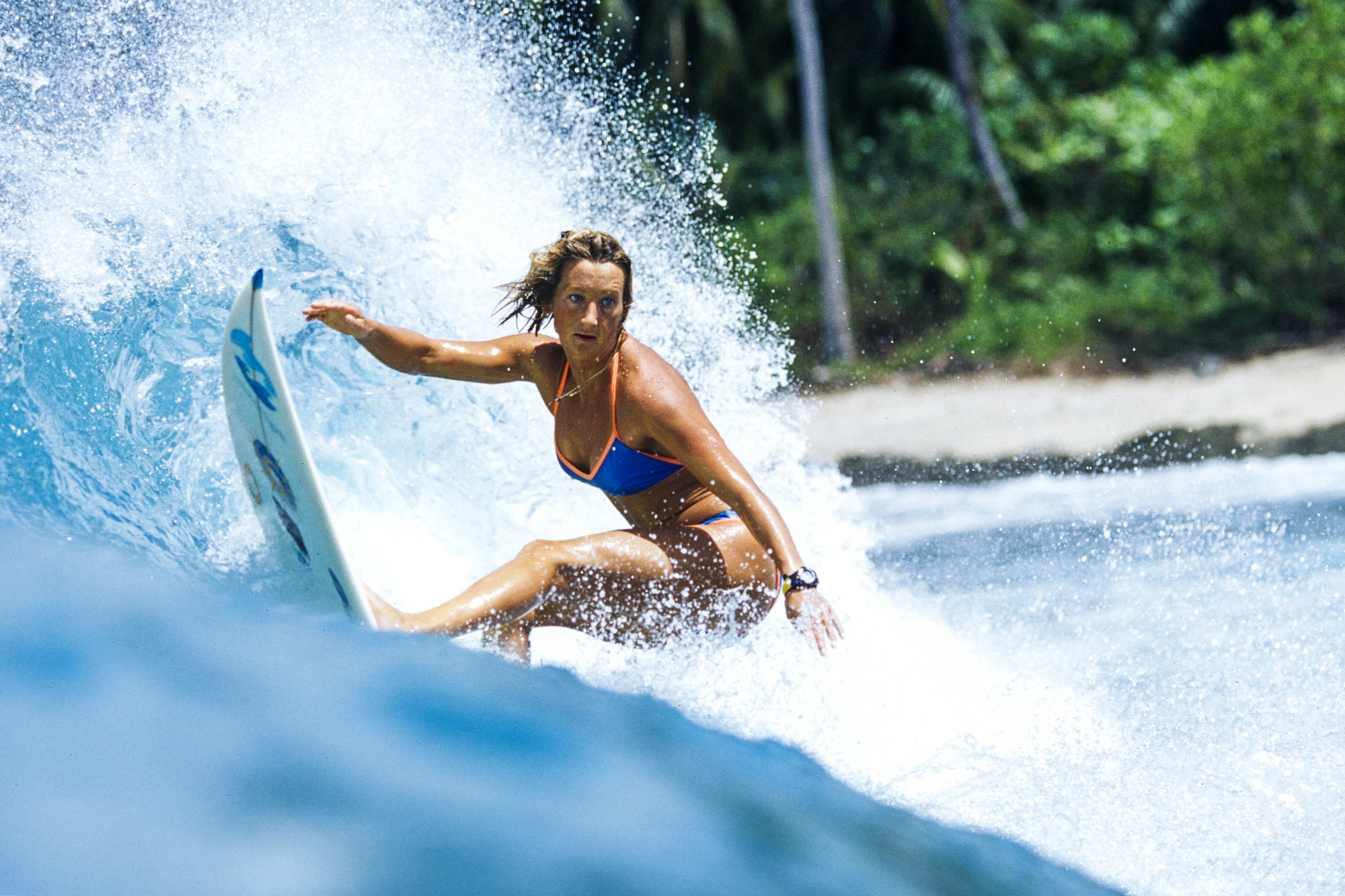In our fifth installment of Surf Cinema Sundays powered by TheSurfNetwork, we showed Blue Crush, included in your Surfline Premium membership. We’ll continue showing iconic surf movies every other Sunday. (Next up: Secrets of Desert Point, May 24th.) If you’re not already Premium, sign up for a Surfline free trial here, and you can also stream/rent the film by going to TheSurfNetwork’s site.
Despite the hundreds of videographers peddling surf porn during the VHS/DVD boom of the mid to late 1990s, viewership was largely polarized into two major moviemaking forces: Basically, you were either a Taylor Steele devotee or you were into …Lost videos. Both camps, however, found a friend in Bill Ballard’s movies.
Born in 1967 on Edwards Air Force Base in Kern County, CA, Bill didn’t start surfing until he was a legal adult, 18. What he lacked in experience, however, he compensated with passion. In 1993, a year after marrying rising surf star Rochelle Gordines and moving to Kauai, Ballard took out a loan to buy his first Canon Hi-8 camera and followed his wife on the ASP World Tour. A girl only had so many heats back then, and Bill swiftly took advantage of the opportunity to film everyone who was anyone in the surfing world. One year and miles of tape later, the great Sonny Miller taught Bill how to edit his footage — in just two days — while Bill crashed in Sonny and Jamie Mausberg’s studio. Six weeks later, Bill finished his first movie, Insanity, which he then sold throughout California out of the trunk of a car he’d purchased for $300. Insanity was well-received, allowing Ballard to start his own video production/distribution company, Billygoat Productions, under which he began churning out surf movies at a feverish rate— at least two a year.
[FAQ: How to watch Surf Cinema Sunday films]
His 1998 project, Blue Crush, was arguably the first of its kind — a high-action, feel-good surf video featuring an all-female cast: Rochelle Ballard, Lisa Andersen, Layne Beachley, Serena Brooke, Megan Abubo and others ripping in Hawaii, Samoa, Australia, South Africa and Mexico. Blending archival footage, light interviews and a timely Rell Sunn tribute — Blue Crush was a raging success, which Bill wisely followed up with three more female flicks. With that, Bill Ballard invented an entirely new genre: the women’s surf movie. Bill now lives just outside Portland, Oregon, with his wife Cara and daughter Daysha, where he produces and manages projects for the Portland agency, North. Surfline rang him up to learn more.
Surfline: Could you list your film credits for us? You’re busy and we’re lazy.
Bill Ballard: The Billygoat Production films: Insanity, Triple C (Crystal Clear Caffeine), Side B, These Are Better Days, The Moment, Iratika, Revelation, The Mystic and Archy. The women’s surf films: Blue Crush, Peaches, Poetic Silence and The Modus Mix. The O’Neill films: The Experience, All Aboard and Ratboy. The HIC film, Rise and Shine (epic Andy stuff), and a fundraiser film, The Union Blue Project, for Jason Bogle, who passed away very young from cancer. I had a bunch of filmmakers from the time each do a section, a very cool collaboration. I joined up with Snapping Turtle’s Jason Kenworthy, Ryan Dival and Ryan Ray for Voluptuous. I also filmed a lot of The Bruce Movie, produced A View From a Blue Moon, and directed and produced John John Florence’s “Twelve” series.

Serena Brooke. Photo: Tom Servais
Thanks. Let’s go ahead and address the elephant in the room: your title, Blue Crush. Were you flattered, embarrassed, or pissed that Universal co-opted your title for a major motion picture four years later? Or were you in cahoots, seeing as many of your subjects ended up being cast and/or hired to do stunt work for the 2002 movie?
Around 1999, a couple good friends of mine, Brendon Lynch and Scott Viscomi, reached out to me about possibly working with the directors and producers of this new Hollywood feature that was in the works, based loosely around women surfers in Hawaii. After a few meetings I got hired to film all the behind-the-scenes, casting, etc. I met with the director, John Stockwell, and we hit it off. From then on I was around everything, videoing so many cool moments as the film began to take shape. The working title was “Surf Girls.” Most everyone didn’t like that, and about a month into actual production a list of potential names got passed around. At that same time, I was thinking about launching “Blue Crush” as a clothing line, so I’d spent the time and money to trademark the name. They got serious about using it, and one afternoon the film’s producer, Brian Grazier, came to the beach and made me a great offer. From then on it was Blue Crush.
You had already produced or co-produced several era-defining surf movies under your emblem, Billygoat Productions, before Blue Crush, arguably the first video of the 1990s VHS/DVD boom to feature an all-female cast. When and how did the idea originate?
I was married to Rochelle Ballard at the time, so every day when I’d film with Andy, Bruce, Sunny, Kalani and so on, there would always be a crew of ladies showing up to surf. We started talking more seriously about making a film with just women and started planning trips, and the next thing you know, we had the makings of a really good film after a couple solid years of filming. The name came about when we were in Samoa. I remember Prue Jeffries, Keala Kennelly and I talking about possible names for the film. One of us said, “Blue Crush,” and boom… I knew right then that that was it.

Layne Beachley. Photo: Tom Servais
What was your favorite part of the whole process — scripting, filming, post-production, promoting, screening, or distributing?
Each phase of making Blue Crush had great moments. Traveling to places and scoring waves is always fun, and editing a section and seeing the film start to come to life with a great song is also a blast. The movie’s editor, Ryan Ray, and I worked together on the majority of films that I did, and he just nailed it with Blue Crush. But if I had to pick one highlight, it was the night we premiered the film. Roxy put on this huge luau on the grassy hills at V-land on the North Shore of Oahu and Randy Hild, then head of Roxy, invited me to show Blue Crush at the event. We premiered the movie that night to a few hundred people, and everyone was so stoked, I knew right away this was a special film. In all my years of making films, that premiere was one of the highlights for sure.
What was the most challenging?
Funding, no question about it. Rochelle was starting to make some good money from sponsors and my films were starting to do good, too, so our bank account basically funded it. I had begun shooting film and bought a really nice 16mm camera, but the whole process of buying film, developing and color correcting the film and transferring it to tape was really expensive. We tried getting major funding from the surf companies and even some outside companies, but no one was really into it. A few companies helped out with small amounts of money, but I paid for most of it with my own money from my other films. It was all so worth it, though. Making Blue Crush was one of the highlights of my surf film career.

Megan Abubo. Photo: Tom Servais
What kind of production team had you assembled for this project in 1998? Who else was instrumental in the success of this movie?
I filmed about 90% of the movie myself, but I definitely had some great people join me along the way, including the surfers themselves. Larry Haynes filmed the majority of the water footage. Todd Lynch, who ran Surfer TV back then, helped put together the Samoa trip. Photographer Jeff Divine and I put together the trip to Mexico. It was a big group effort. Watching it today, I get a big smile on my face. It was all so fun. I never went to school for film, I just learned things as I went along. I feel so fortunate to have been able to travel and film for the years that I did. I’m so thankful for that.
What’s your favorite section?
Probably Samoa. We spent seven days on Samoa and six days on Savaii, and it was all so raw. The people on both islands were just wonderful. I’ve always wanted to go back but just haven’t made it.

Serena Brooke. Photo: Tom Servais
In hindsight, what do you feel is Blue Crush’s greatest contribution to surf culture? And what kind of impact did it have on subsequent generations of female surfers?
I feel like Blue Crush empowered female surfers. They were so undervalued and really had to prove themselves every step of the way to get anything. At the time when Blue Crush came out, it was the beginning of this big boom in women’s surfing. Women’s surf brands were taking off, there was a handful of women’s surf magazines — it was all just going off at the same time. Blue Crush was able to give the ladies another platform to show the world just how amazing they were. Other than surf contests or the odd picture in a magazine, the majority of the surfing world hadn’t seen just how great they were. Beyond that, I really have no way of knowing just how much of an impact the film itself truly had. The women who surfed in the film are the ones who made the impact.
What do you find shocking, disturbing or inspiring about the state of surf cinema today?
I don’t really see anything that is disturbing, but then again, I’m a little removed from it all now. I do think it’s cool that so many surfers are taking the reins themselves and producing their own surf films. John John has led that wave in this latest generation of surfer/filmmakers, but there are so many now, it’s really cool to see.

Lisa Anderson. Photo: Tom Servais
What is your favorite surf movie of all time?
I have a few: Blazing Boards by Chris Bystrom, Sonny Miller’s Searching For Tom Curren, Jack McCoy’s Bunyip Dreaming and Surfers the Movie by Bill Delaney.
Premium Perks: One Free Surf Movie Rental From TheSurfNetwork. Eligible Premium members redeem here.
Surf Cinema Sundays Schedule

Bustin Down the Door. March 15
Letting Go. March 29
One California Day. April 12
Super Session. April 26
Blue Crush. May 10
Secrets of Desert Point. May 24
Endless Summer. June 7
Dark Fall. June 21
Secret Machine. July 5
Five Summer Stories. July 19
The Kill 2. August 2
Rolling Thunder. August 16